Related Research Articles

China has great physical diversity. The eastern plains and southern coasts of the country consist of fertile lowlands and foothills. They are the location of most of China's agricultural output and human population. The southern areas of the country consist of hilly and mountainous terrain. The west and north of the country are dominated by sunken basins, rolling plateaus, and towering massifs. It contains part of the highest tableland on earth, the Tibetan Plateau, and has much lower agricultural potential and population.

The Uyghurs, alternatively spelled Uighurs, Uygurs or Uigurs, are a Turkic ethnic group originating from and culturally affiliated with the general region of Central and East Asia. The Uyghurs are recognized as the titular nationality of the Xinjiang Uyghur Autonomous Region in Northwest China. They are one of China's 55 officially recognized ethnic minorities. The Uyghurs are recognized by the Chinese government as a regional minority and the titular people of Xinjiang.

East Turkestan or East Turkistan, also called Uyghuristan, is a loosely-defined geographical region in the northwestern part of the People's Republic of China, which varies in meaning by context and usage. The term was coined in the 19th century by Russian Turkologists, including Nikita Bichurin, who intended the name to replace the common Western term for the region, "Chinese Turkestan", which referred to the Tarim Basin in Southern Xinjiang or Xinjiang as a whole during the Qing dynasty. Beginning in the 17th century, Altishahr, which means "Six Cities" in Uyghur, became the Uyghur name for the Tarim Basin. Uyghurs also called the Tarim Basin "Yettishar," which means "Seven Cities," and even "Sekkizshahr", which means "Eight Cities" in Uyghur. Chinese dynasties from the Han dynasty to the Tang dynasty had called an overlapping area the "Western Regions".
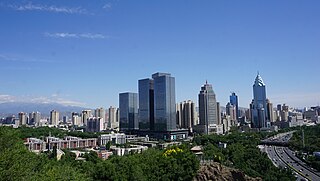
Ürümqi, formerly known as Dihua, is the capital of the Xinjiang Uyghur Autonomous Region in the far northwest of the People's Republic of China.
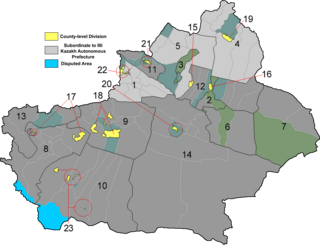
The Xinjiang Production and Construction Corps (XPCC), also known as Bingtuan, trading as the external name China Xinjian Group, is a state-owned enterprise and paramilitary organization in China's Xinjiang Uyghur Autonomous Region (XUAR).

The time in China follows a single standard time offset of UTC+08:00 based on the National Time Service Center of Chinese Academy of Sciences located in Mount Li, Lintong District, Xi'an City, Shaanxi Province, even though the country spans almost five geographical time zones. The official national standard time is called Beijing Time domestically because based on 120th meridian east that Beijing City is located, and China Standard Time (CST) internationally. Daylight saving time has not been observed since 1991. China Standard Time (UTC+8) is consistent across Mainland China, Hong Kong, Macau, Taiwan, as well as equivalent with Philippines, Singapore, Brunei, most of Mongolia, Malaysia, Irkutsk Time (Russia), Western Australia and Central Indonesia.

Xinjiang is historically consisted of two main geographically, historically, and ethnically distinct regions with different historical names: Dzungaria north of the Tianshan Mountains; and the Tarim Basin south of the Tianshan Mountains, currently mainly inhabited by the Uyghurs. They were conquered by the Qing dynasty in the 18th century, and after the Dungan Revolt (1862–1877) the Qing reconquered both regions and integrated them into one province named Xinjiang in 1884.

Hotan Prefecture is located in the Tarim Basin region of southwestern Xinjiang, China, bordering the Tibet Autonomous Region to the south and Union Territory of Ladakh and Gilgit-Baltistan to the west. The vast majority of the Aksai Chin region which is disputed between China and India is administered as part of Hotan Prefecture. The seat of Hotan Prefecture is Hotan and its largest county by population is Karakax County. The vast majority of the residents of the prefecture are Muslim Uyghurs and live around oases situated between the desolate Taklamakan Desert and Kunlun Mountains.

Xinjiang Medical University (XMU), formerly the Xinjiang Medical College, is a medical university in Ürümqi, the capital of the Xinjiang Uyghur Autonomous Region of the People's Republic of China. It was ratified by the National Ministry of Education in 1998 and entitled by Jiang Zemin.
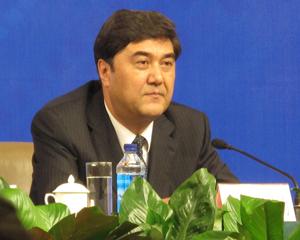
Nur Bekri is a Chinese former politician of Uyghur ethnicity, best known for his term as Chairman of the Xinjiang Uyghur Autonomous Region between 2008 and 2014. Between 2014 and 2018, he was vice-chairman of the National Development and Reform Commission and Director of the National Energy Administration, with rank equivalent of a minister. Bekri was one of the highest ranked ethnic minority officials in the Chinese government.

Xinjiang, officially the Xinjiang Uygur Autonomous Region, is an autonomous region of the People's Republic of China (PRC), located in the northwest of the country at the crossroads of Central Asia and East Asia. Being the largest province-level division of China by area and the 8th-largest country subdivision in the world, Xinjiang spans over 1.6 million square kilometres (620,000 sq mi) and has about 25 million inhabitants. Xinjiang borders the countries of Afghanistan, Kazakhstan, Kyrgyzstan, Mongolia, Pakistan, Russia, Tajikistan, and India. The rugged Karakoram, Kunlun and Tian Shan mountain ranges occupy much of Xinjiang's borders, as well as its western and southern regions. The Aksai Chin and Trans-Karakoram Tract regions are administered by China but also claimed by India. Xinjiang also borders the Tibet Autonomous Region and the provinces of Gansu and Qinghai. The most well-known route of the historic Silk Road ran through the territory from the east to its northwestern border.
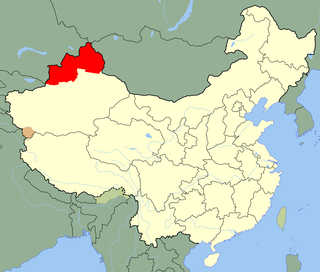
The Ili Rebellion was a separatist uprising by the Turkic peoples of northern Xinjiang against the Kuomintang government of the Republic of China, from 1944 to 1946. The Ili Rebellion began with the East Turkestan National Revolution, known in Chinese historiography as the Three Districts Revolution, which saw the establishment of the Second East Turkestan Republic. The leadership was dominated by Uyghurs but the population consisted mostly of Kazakhs.

Tiemenguan is a county-level city in Xinjiang Uyghur Autonomous Region, China. It is located 50 kilometres (31 mi) west of Korla and 500 kilometres (310 mi) southwest of the regional capital Ürümqi.
Shuanghe is a county-level city in Xinjiang Uyghur Autonomous Region, China. It is located 30 kilometres (19 mi) east of Bole City and 50 kilometres (31 mi) southwest of Alashankou and the border with Kazakhstan. Shuanghe governs an area of 742.18 square kilometres (286.56 sq mi) and has a population of 53,800.

The Dzungar genocide was the mass extermination of the Mongol Dzungar people by the Qing dynasty. The Qianlong Emperor ordered the genocide after the rebellion in 1755 by Dzungar leader Amursana against Qing rule, after the dynasty first conquered the Dzungar Khanate with Amursana's support. The genocide was perpetrated by Manchu generals of the Qing army, supported by Turkic oasis dwellers who rebelled against Dzungar rule.
Kokdala or Cocodala is a city in northern Xinjiang, China, bordering Kazakhstan's Almaty Region to the west. Administratively, it is a county-level city under the direct administration of the regional government, though it is geographically located in the Ili Kazakh Autonomous Prefecture. Kokdala is the headquarter of the 4th Division of Xinjiang Production and Construction Corps and currently administered by the 4th Division. The city implemented the "division and city integration" management system, it shares the same leader group with the 4th Division.
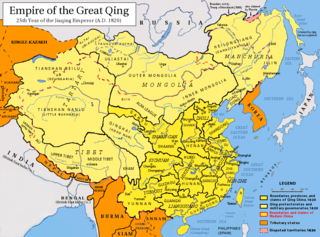
The Qing dynasty in Inner Asia was the expansion of the Qing dynasty's realm in Inner Asia in the 17th and the 18th century AD, including both Inner Mongolia and Outer Mongolia, both Manchuria and Outer Manchuria, Tibet, Qinghai and Xinjiang.

The Manchu-led Qing dynasty of China ruled over Xinjiang from the late 1750s to 1912. In the history of Xinjiang, the Qing rule was established in the final phase of the Dzungar–Qing Wars when the Dzungar Khanate was conquered by the Qing dynasty, and lasted until the fall of the Qing dynasty in 1912. The post of General of Ili was established to govern the whole of Xinjiang and reported to the Lifan Yuan, a Qing government agency that oversaw the empire's frontier regions. Xinjiang was turned into a province in 1884.

The Xinjiang internment camps, officially called vocational education and training centers by the government of China, are internment camps operated by the government of Xinjiang and the Chinese Communist Party Provincial Standing Committee. Human Rights Watch says that they have been used to indoctrinate Uyghurs and other Muslims since 2017 as part of a "people's war on terror", a policy announced in 2014. The camps have been criticized by the governments of many countries and human rights organizations for alleged human rights abuses, including mistreatment, rape, and torture, with some of them alleging genocide. Some 40 countries around the world have called on China to respect the human rights of the Uyghur community, including countries such as Canada, Germany, Turkey, Honduras and Japan. The governments of more than 35 countries have expressed support for China's government. Xinjiang internment camps have been described as "the most extreme example of China's inhumane policies against Uighurs".

The Chinese government has committed a series of ongoing human rights abuses against Uyghurs and other ethnic and religious minorities in Xinjiang that is often characterized as genocide. Beginning in 2014, the Chinese government, under the administration of Chinese Communist Party (CCP) General Secretary Xi Jinping, incarcerated more than an estimated one million Turkic Muslims without any legal process in internment camps. Operations from 2016 to 2021 were led by Xinjiang CCP Secretary Chen Quanguo. It is the largest-scale detention of ethnic and religious minorities since World War II. The Chinese government began to wind down the camps in 2019. Amnesty International states that detainees have been increasingly transferred to the formal penal system.
References
- ↑ "Chinese Exploration and Excavations in Chinese Central Asia". British Library / International Dunhuang Project. Archived from the original on 2017-06-10.
- Hummel, Arthur W. Sr., ed. (1943). . Eminent Chinese of the Ch'ing Period . United States Government Printing Office.